

Rowan Castle - Travel & Photography

© Rowan Castle 2019


Brazil 2002 - Diary (Page 2)


down onto the rainforest, and in the near distance, dramatic mountains of the
Sierra Neblina. From this point onwards the landscape changed dramatically. We
left the trees behind, and trekked through a weird landscape of mud, palms,
bromeliads, roots, underground streams and quartz rock. As we neared Pico da
Neblina Base Camp, Val pointed out a large mound of loose quartz by the side of
the trail. It had been excavated by gold miners who intended to search it for
gold, but presumably hadn’t returned to finish the job.
The blue morpho butterfly wing that we found.
A rare view out of the rainforest, from near the pass.
Me, approaching the base camp of Pico da Neblina.
I reached the Base Camp with Valdir, slightly ahead of the rest of the group.
There were a couple of existing frames for the shelters in place, and the porters
had already set up a blue tarpaulin over one of them to form the kitchen area.
The camp was located in a very pretty spot, at the junction of two small creeks.
It was obvious that gold miners had previously used the area, because there
were signs of old shelters and the ground had been stripped down to the quartz
gravel underneath. However, beyond the small clearing of the camp was an
incredible landscape of rocky outcrops, carpeted with palms, bromeliads and
other strange plants. It really was a ‘lost world’ and I half expected to see a
dinosaur at any moment! I set up my tripod and took a couple of photographs of
the camp, before James came down the trail. He told me that he and Bill had
discovered a beautiful orchid near the path and that I might want to come and
have a look. After a few minutes of searching, we found the right spot. Sure
enough, there was an orchid growing there with three small but stunning
flowers. It has been estimated by botanists that sixty percent of the plants on
the slopes of Neblina are unique to the area and new to science.
Our base camp on Pico da Neblina.
The orchid at base camp.
After I had set up my hammock in camp, I set off to explore the gully formed by
the larger of the two creeks. It seemed that this small river was actually the
beginnings of Tucano Creek that we had navigated earlier in the boat. A path led
a short distance along the left hand bank, but after that the going was far from
easy, and I found myself clambering over many large boulders. In the dense
undergrowth on the high banks above the creek, I occasionally saw
hummingbirds searching for flowers. Within a short distance from the camp, I
found a second orchid. It was not as spectacular as the one that Bill and James
had discovered, having only small yellow flowers.
After picking my way over and around the rocks, I discovered that the creek
widened into a beautiful and secluded area where the clear water flowed slowly
past a wide sandy shore. There were several flower-covered bushes on the
banks of the stream, and after a few minutes a dazzling green hummingbird
with white outside tail feathers flew in to feed on the nectar. It was a magical
spot, and I re-visited it several times before nightfall to show some of the rest
of the group.
Back in camp, Graham and I were chatting before dinner, when a green
hummingbird with an iridescent blue throat flew into our shelter. It buzzed
round our heads for a few seconds and then flew off. We learnt that the
hummingbirds in the area are fairly tame because they have seen few humans.
Also, the gold miners that live on the mountain have made a habit of feeding
them and so they associate people with food. Valdir had filled a plastic mug
with sugar-water and hung it up on a nearby branch. The local hummingbirds
took full advantage of this free source of energy and quite often perched on the
cup to feed.
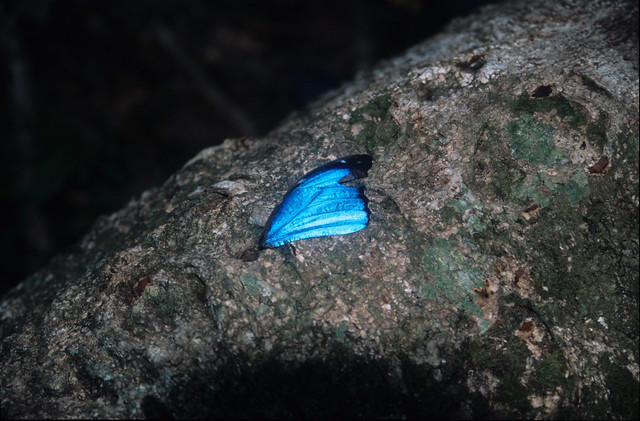
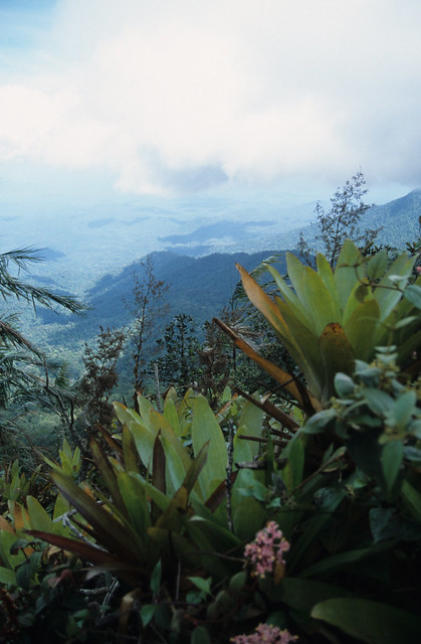

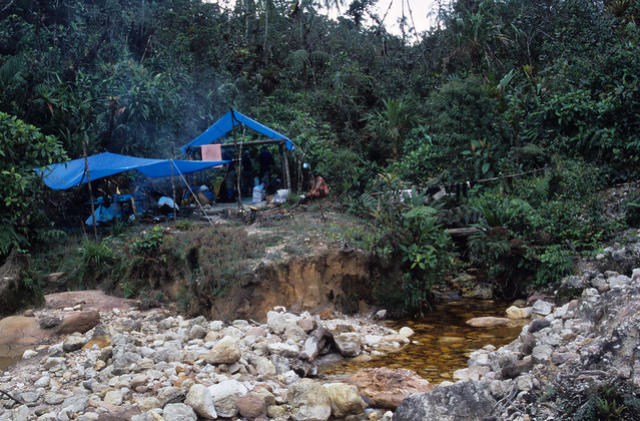
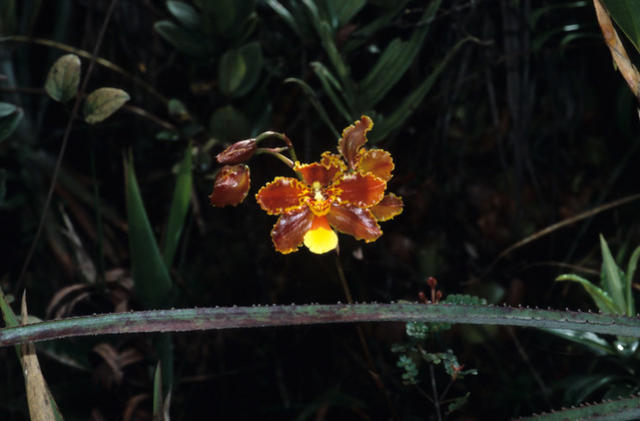
Day 8 – Saturday 14th September (Summit Day).
The whole group was awake at 05:15 to ensure an early start for the summit
climb. We had a hurried breakfast, and in the pale dawn light Valdir gave us a
briefing on the climb ahead. He explained that there was a creek that had to be
crossed during the trek up the lower slopes, but it could not be forded after
heavy rain. This meant that if it started to rain heavily while we were high up
on the mountain, we would have to race back down to base camp to avoid being
stranded. He expected that reaching the summit and getting back to camp
would take at least twelve hours and it would be important for us to keep up
with his pace if we were to make it back before dark. Brian announced that he
would not be going with us to the summit, because he didn’t feel like it and
would rather spend the day exploring the base camp. Naturally, we were all sad
that he wouldn’t be climbing with us, but respected his decision. Before we set
off, Bill rummaged in his backpack and gave each of us one of the power bars
that he had brought with him from the US. It was very generous of him, and was
a welcome boost to our energies before what was sure to be a testing day. Each
of us took only the absolute basics with us on the trek to the summit – a water
bottle, waterproofs and our cameras. I also opted to take my GPS receiver with
me, because I wanted to get an accurate fix of the position of the summit.
A rare glimpse of Pico da Neblina - it is usually shrouded by mist.
We set out at 06:40, briefly retracing our steps back along the trail, before
following a left hand fork towards Neblina. This first took us through an area
that had been heavily excavated by gold miners and then plunged into a four
hour stretch of thick mud and tangled roots. There were high earth banks to
each side, and dense vegetation on top of these, so that we were trekking along
corridors through the foliage. Some of the mud pools here were more than knee
deep and it would have been so easy to break an ankle on the hidden roots and
rocks. Sometimes our legs sank deep into the black mud and it was so thick and
viscous that it was a struggle to break free. Another hazard were roots that had
been chopped through with a machete to clear the path. The cut ends of the
roots were often very pointed and if not seen in time they smashed painfully
into a knee or a thigh.
Reaching the creek that Valdir had warned us about, we found that fortunately
it contained very little water and was easily crossed. The banks of the stream
were crowded with vegetation, including a shrub-like plant with many beautiful
small pink flowers. After re-filling our water bottles we continued along the
muddy path.
At this point Valdir had gone far ahead, I was trekking a little way behind David,
and James was back at the tail of the group. I came round a bend in the track
to find that it forked. I was just in time to see David about to disappear out of
sight along the left hand fork, but I noticed that someone had bent two thin
saplings across each other at the mouth of that path. These indicated that the
left fork was not the way to the summit. It was a subtle sign that was easy to
miss, and David must have walked straight past it. I called out to him and he
rejoined me on the correct path. It was lucky that I saw him when I did. After
this incident I was rather concerned about how easy it was to lose the way and
decided that I would make an effort to catch up with Val at the front. It was
hard work to put on extra speed through the thick mud but I made it. Walking
behind Val seemed to make the climb easier, because he knew the terrain so
well. I reasoned that if I stepped where he stepped and kept to his pace, I
would have a good chance of making it to the top and back down safely. We
were also fortunate in that James and Val were equipped with two way radios
so that they could communicate fairly easily, even over some distance, and
keep the group together and on track. One consequence of moving to the front
of the group and trekking with Val was that I missed an interesting discovery by
James and Bill. They came across a small black scorpion resting in leaf litter at
the side of the trail. I have never seen a scorpion in the wild.
Valdir on the radio.
Having reached the end of the muddy section, we could see that the path
climbed extremely steeply up a cliff face. It was quite exposed in places, and
several short sections were actually basic rock climbs or scrambles. At one point
in the climb a trio of scarlet macaws flew past at eye level, giving us a welcome
distraction from the drop off nearby. I found one small rock chute particularly
difficult to climb, because the handholds were far apart and slippery because of
the water and algae on the surface of the stone. At another, there was a
permanently fixed knotted rope that allowed us to haul ourselves up. This
section of the climb was incredibly demanding, and there was no let up in
either the pace or the steepness of the ground.
After the cliff came an easier (but still steep) section over quartz rocks. The
plant life here was very interesting; we saw a beautiful orchid, carnivorous
pitcher plants and another interesting insect-eating plant, the bladderwort. The
bladderworts on Neblina grow in the small pools of water that collect inside
bromeliads. Once established they send up a single green stem, topped with a
beautiful lilac flower. The roots that grow inside the pool of water have little
sacks (bladders) on their ends. The plant pumps the water out of these bladders
to create a partial vacuum and when a tasty morsel floats close by, a trapdoor
opens in the bladder and the insect is sucked inside to be digested. We took a
rest at this point, while we examined the interesting plants. Unfortunately, I
had put my camera away and so missed the chance to photograph a beautiful
hummingbird that perched on the branch of a small tree, just feet away from
us!
Eventually, we reached the foot of some formidable looking cliffs and had our
lunch while perched on a steep bank of rocks. Looking at the way ahead, I was
beginning to wonder if I was going to make it to the summit. By this stage,
Carolyn’s knees were hurting badly, so she and Del decided to go back. Tomei,
one of our Yanomami porters helped her all the way back down to the base
camp. That left four clients, Bill, David, Graham and I, plus Marcello, Valdir and
James, to push on to the summit.
Just after the lunch stop we came to an almost sheer rock face some fifteen
feet high that was safeguarded by a knotted rope. I climbed up very carefully,
trying hard to keep a tight grip on the sodden and slippery rope. When I got to
the top I found a narrow ledge with a nasty drop off to the left, and I rested
against the rock while I got my breath back. Next to me on the ledge were the
troops from the Brazilian army unit who were on their way back down from the
summit, having completed their repairs to the flag. They were waiting patiently
for us to ascend before they could use the rope to get down. When the others in
our party reached the top, Valdir told me that the leader of the Brazilian army
unit wanted to talk to me and pointed him out. I made my way over somewhat
nervously; why on earth would he want to speak to me? The army man spoke
briefly to one of his sub-ordinates, who to my amazement began cutting the
Brazilian flag from his uniform. The leader then presented this to me, with a
salute. By now I was totally confused, and so I just saluted back and thanked
him. They made their way down the rope, and I turned to Valdir in the hope of
an explanation. Apparently, the leader of the army group had seen my very
short haircut (a number 3) and had assumed that I was in the UK army. He had
decided to give me the Brazilian flag from the uniform as a goodwill gift. I was
amazed, but very grateful and I still have the army patch that he gave me.
Me, climbing the final fixed rope before the summit.
The Brazilian Army unit. Thanks to Bill Scroggie for the use of this
photograph.
From this point the path to the summit was a very steep rock scramble that was
exposed in places. Fortunately, we were now amongst the clouds and they
shielded us from seeing just how nasty the drop offs probably were. Everyone
was very tired, and wondering how much further there was to go, when we
finally sighted the Brazilian flag fluttering above the summit cairn. A few
minutes later, and we stood on the roof of Brazil, at 9,888 feet (3014 metres)
above sea level. As I reached the top (at 12:04) I shook hands with Valdir and as
each member of the group joined us, we congratulated each other on
completing such an arduous climb. I marked the position of the summit on my
GPS receiver and then we took group photographs next to the flag. Each of us
signed the summit book, which Brasil Aventuras had placed underneath the
summit cairn in a tupperware box. I wrote:
“Rowan Lee Castle (British and Canadian) at 12:21 on 14th September 2002. A
stunning mountain!”
We spent about one hour on the summit, during which the dense cloud that
surrounded us parted briefly only once, to reveal a memorable view straight
down onto the canopy of the Venezuela rainforest on the other side.
Me, on the summit of Pico da Neblina, Brazil’s highest mountain.
Marcello and Valdir on the summit of Pico da Neblina.
Then began the long down-climb back to our camp. It was very difficult to make
our way down over the slippery rocks, and of course this time we were facing
the drop offs, which made it more unnerving. I had particular problems on one
steep section not far below the summit, and James took my camera and helped
me to find sturdy foot and hand holds. When we reached the knotted rope down
the rock face where we had met the soldiers, I went down first. It was more
frightening to descend than it had been on the way up, because I had to lower
myself backwards and the rope was very difficult to grip. I wasn’t surprised
when Graham asked James to belay him with the safety rope as he came down
after me.
We had a rest stop by the foot of the crags, in exactly the same place where we
had lunch. I took a photograph of James next to the precipice, with
neighbouring mountains as a backdrop. From this vantage point we could just
see the lip of the Rio Baria canyon, the deep and unexplored rift that cuts right
into the Neblina massif.
Our guide James at the rest stop. The lip of the Rio Baria canyon is on
the far right.
When we reached the treacherous cliff section, it was my turn to ask to be
belayed with the safety rope, to help me descend the awkward rock chute that
had caused me such difficulty on the way up. I remember another tricky part of
the cliff very vividly. It was another short scramble down a rock chute, onto a
very narrow path next to a big drop off. We had to climb down this facing the
rock, and the very last section was an awkward step backwards off one of the
footholds. As I stepped down, I overbalanced backwards and stumbled towards
the drop. Luckily for me, Valdir was watching my descent closely, and as I
stepped back, he put his arm out behind me and stopped me going any closer to
the cliff.
When at last we reached the foot of the cliff, it was time to retrace our steps
through the seemingly unending mud pools and roots that lay between the camp
and us. By this time we were all exhausted, my knees hurt with every jar from a
submerged rock or sharp contact with the end of a root. It really was difficult at
times to summon the energy to lift my feet out of the black mud ooze.
Exactly twelve hours after we had set out to the summit, we returned to our
base camp. Brian, Carolyn and Del all came out of their hammocks to
congratulate us and Brian passed around a very welcome hip flask full of Scotch
whiskey. I was shattered after the climb, which was definitely the most
demanding I had done. I had just about enough energy to re-arrange my pack
and eat my dinner of potato, rice and vegetable stew, before heading to my
hammock for some much needed sleep.
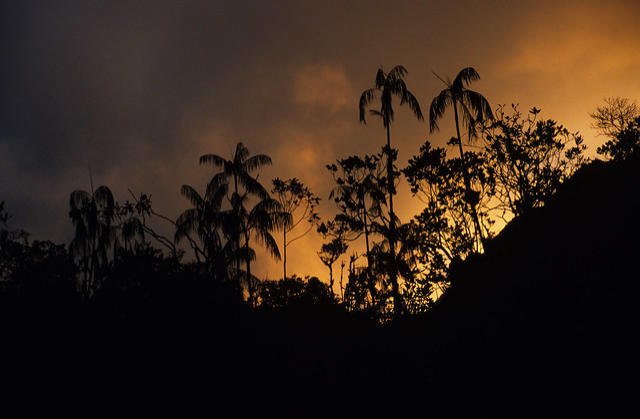
Sunset at Pico da Neblina base camp.
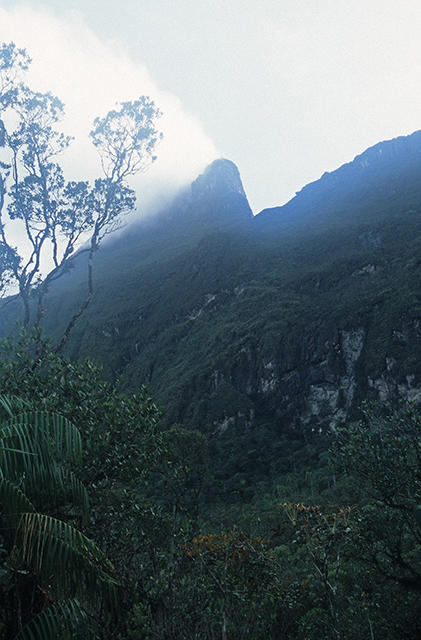
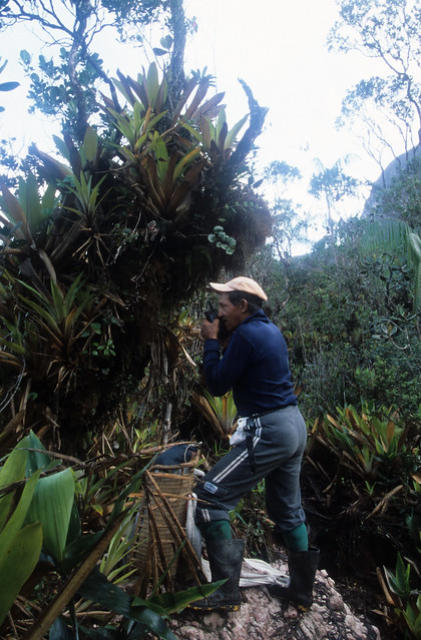
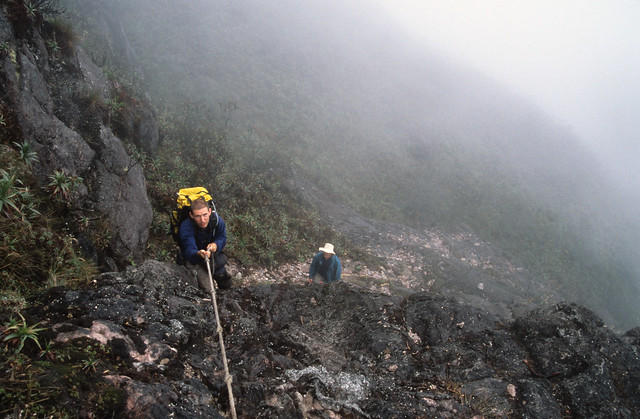

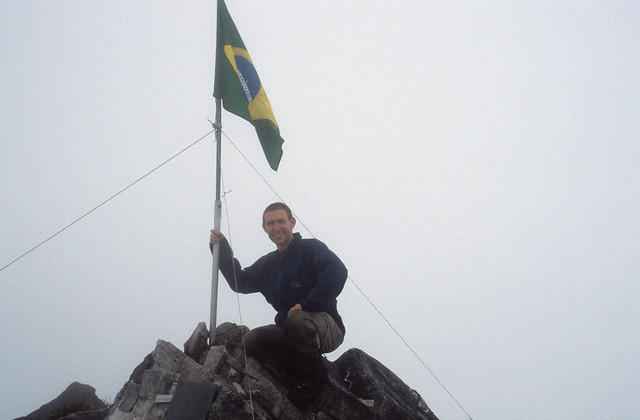
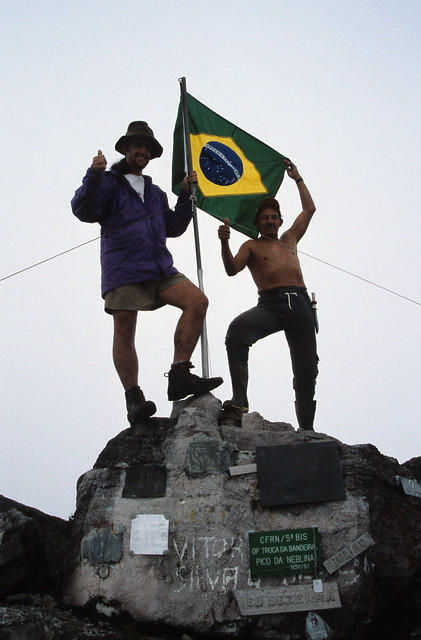
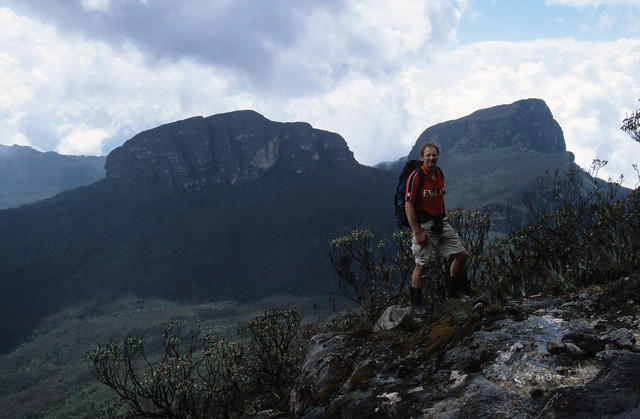
Day 9 – Sunday 15th September (Rest Day).
It had been an uncomfortable and chilly night in the hammock, with a cold
persistent wind blowing in under the tarpaulin. I had breakfast, with delicious
hot chocolate, and then I took my camera, zoom lens and tripod down the creek
to the magical spot I had found before. This was our rest day after the summit
climb, and I had decided to spend the morning relaxing by the creek and trying
to photograph the hummingbirds feeding on the flowering bushes. It was the
hope of being able to photograph hummingbirds in the wild that had led me to
bring along my tripod and zoom lens in the first place, and make the effort to
carry them all the way up through the jungle. I soon had my equipment set up
as close to the nearest flowering shrub that I could find, and then it was just a
matter of waiting patiently. I had read that hummingbirds are very territorial
and must feed constantly to stay alive, so I reasoned that I would have a fair
chance of capturing one on film. In the end, I discovered that a hummingbird
(perhaps the same one) visited this particular bush roughly every half an hour.
Even with the modern features of my camera such as fast auto-focus and a high
shutter speed it was very difficult to photograph these extremely quick and
agile birds. The action head on my tripod proved indispensable. It looked a bit
like the brake on a bicycle handlebar and with one squeeze of the lever the
head and camera could be swiveled to the desired position, but as soon as the
pressure was released it locked solidly in place. This allowed me to quickly
follow the bird as it darted around the flowers and fire the shutter as soon as
the head was locked in place. It took me the whole morning and an entire roll
of film to get a handful of shots that I thought might have worked. Fortunately
when I was back in the UK and had the slide film developed, I found that the
results from a few of the shots exceeded my expectations. I thoroughly enjoyed
that morning by the creek, and it was impossible to tire of watching these
dazzling little birds.
Yellow orchid flowers near base camp.
A hummingbird near the base camp on Pico da Neblina.
I got back to the camp just in time for lunch. As we sat around on the log
benches next to our camp a hummingbird flew up to us, and fed from the
plastic mug of sugar water, often when one of us was holding it! One bird flew
right into the middle of our group, hovered, and looked at each one of us in
turn before darting away.
A few of the others in our group had spent the morning up at the gold miner’s
camp. They told me that the miners had been very hospitable and even given
them some food. Unfortunately, the only thing that they had to offer was a
lump of animal fat that they heated over the fire. Bill told me that during the
cooking process, it quite often caught light and had to be hurriedly
extinguished. Bill had done his best to eat it, not wanting to appear ungrateful,
but said that it was almost inedible. Apparently the miner’s camp only consisted
of a pole shelter like ours, but with blue tarpaulins on all sides to try to keep
out the wind. They had rigged up many sugar feeders for the friendly
hummingbirds, which were constant visitors. The miners had been enduring
these extremely tough living conditions for eleven years. They had so little that
they used notebook paper to roll cigarettes. While I was at the base camp, the
three miners paid us a visit, and even showed us their precious stash of gold
dust.
A rainstorm blew in, the others retired to their hammocks, while I sat by the
fire in the kitchen part of our shelter, drinking cappuccino and chatting to Val.
While I sat there, a hummingbird flew in and tried to drink from my mug of hot
cappuccino! Then it moved on to trying to sip sugar from the lids of the bottles
of juice that we had. Val and I had to wave it away from the juice bottles,
because whoever bought the supplies had mistakenly got us diet ones for the
trek and these would be harmful to the hummingbird, because the artificial
sweetener would not give it the energy it needed to survive. These birds require
so much energy just to stay alive that they live constantly on the brink of
disaster, and I remember seeing a documentary that showed they could only
afford to stop feeding to go to sleep at night because they slow their
metabolism right down when they roost.
As the rain cleared I watched Val tidying up and doing tasks around the camp.
His jungle skills were remarkable. With a machete, he cut a nearby piece of
wood to the right size and within a few seconds had shaped one end to make a
new handle for our shovel. It fitted perfectly into the shovelhead at the first
attempt. When we had been trekking, I had seen him draw and throw his
survival knife in the blink of an eye, and he buried the blade right up to the hilt
in the stem of a banana tree.
My most remarkable encounter with the hummingbirds happened that
afternoon. I decided to sit out on one of the log benches and hold out the blue
mug full of sugar water, in the hope that one of the birds would feed from it. I
had quite a long wait, but eventually, one came down and actually perched on
my thumb as it drank from the mug! It was so light that there was hardly any
pressure from its little feet on my skin. I could feel the down draft of air from
its rapidly moving wings. It didn’t settle down completely, presumably in case it
felt threatened and decided to make a quick getaway. After a few memorable
seconds it finished drinking and flew off to the safety of a nearby branch.
We were all very glad that we had been given the chance to spend a day in this
incredible and remote place, and we also needed the recuperation time. My
legs and knee joints ached terribly from the descent the day before, and it was
the first time I had experienced anything like it, even after a long trek. Walking
any distance around the camp required a lot of effort.
After dinner, I was glad to retreat to my hammock once more, but it was not a
peaceful night. The temperature dropped considerably and a gusty wind
buffeted the shelter. I found it very difficult to sleep and couldn’t wait for the
sun to rise.


Day 10 – Monday 16th September.
I got out of my hammock at 05:30 and we had a breakfast of porridge before
setting off down the trail at 07:30. We went back down the same route that had
brought us up the mountain, so once again we navigated our way over and
around the roots, boulders and mud that made up this strange part of the world.
A steep and tortuous descent, that was hard on the knees, took us back down to
the forested ridge. The three gold miners passed us on the trail. We didn’t know
it at that point, but they were heading for Sao Gabriel and decided to come
along with us. This was to cause a great deal of friction within our group before
the trek was over.
Once again I was walking up front with Val, who was now setting a furious pace.
I could only just manage to keep up with him. Val and I arrived at Bebedo Camp
(where I had smashed my toe on a rock before) roughly half an hour before the
rest of the group, and this was where we all stopped for lunch.
The afternoon was a grueling trek along the undulating path, which took us to
our camp for the night at Bebedo Vehlo. This was the spot where Pepe had
caught the giant worm previously. Val and I were able to keep in touch with the
rest of the group by radio during the descent, although the ups and downs of
the terrain meant that often our messages were broken up or distorted. We
arrived at Bebedo Vehlo at about 16:30.
When everyone had made it into the camp we learnt that the gold miners would
be camping with us and were also going to be sharing our boat. As I mentioned
earlier, several members of our party were not at all happy about this. It didn’t
bother me particularly, as this is how life in the jungle works. If others need
transportation and are prepared to do their bit then there is not a lot that can
be done about it. Unfortunately in this case the miners tried to pacify the
opposition by claiming that one of them had suffered internal injuries while
digging for gold and needed to get to hospital. This patently wasn’t true, but as
I’ve said, I had no reason to object to them coming along for the journey back,
especially after they had been so hospitable to our party at the base camp. The
existing shelter at Bebedo Vehlo was old and rotten, and I noticed how all three
of the miners worked extremely hard to help our Yanomami porters to construct
a new one.
The new shelter was completed just in time. I had only just finished rigging up
my hammock and mosquito net when a terrific thunderstorm struck and the
jungle trees were rocked by a powerful wind. Suddenly I heard James shout a
frantic warning to us to get out of the shelter. I have never got out of a
hammock so fast! We all raced outside into the rain. James had rightly been
worried about the possibility of dead branches falling from the nearby trees and
landing on our shelter. Once the wind had lessened slightly we felt it was safe to
take refuge under the tarpaulin once again. The downpour was torrential and
we were forced to eat our evening meal standing between the hammocks.
Day 11 – Tuesday 17th September.
Today was our last day of trekking in the jungle. We trekked at a very fast pace
down to the Tucano Falls camp, where I had seen the big tarantula. Near the
clearing where we had camped was an old Yanomami plantation of banana
trees. We made our way between their stems until Val found a huge bunch of
bananas on the ground and handed them out. They were perfectly ripe and
delicious.
Val was concerned that the river we had forded before, that lay between the
banana plantation and the camp, may have risen after the rains and be too high
to cross. Luckily, this turned out not to be the case and the river looked no
different than during our previous crossing. It was very hot and humid here, so
we were all glad of the opportunity to have a refreshing swim before continuing
the trek. Val told us that when the Yanomami first came to this camp from
Venezuela, there had been a big battle between two family groups. He said that
the graves of seven Yanomami warriors lay up on the bank.
We paused briefly in our old camp, just long enough to sort out our rucksacks
and then set out again for the boat. I was up at the front of the group again
with Val, and when the trail took an odd turn or the route was difficult to see,
he cut saplings and put them across the wrong path so that the rest of the
group would not get lost. At one large fork in the path, the right hand branch
had a stick placed across it at waist height. Val said that this path led to the
Yanomami village of Maturaca after a few days of walking, but that the village
was out of bounds to foreigners by order of the government. However, if any
emergency had happened on Neblina to one of our group, they would have had
to be carried to the airstrip at Maturaca to be airlifted out. This was a sobering
reminder of how remote Neblina is and how difficult it would be to rescue an
injured trekker.
On the way to the boat Val and I saw several tiny leaf-coloured frogs that had
been encouraged to come out by the recent rain. We also disturbed a very large
brown lizard that shot off through the leaf litter as we approached. On one very
dark and dank stretch of the path we saw two brightly coloured heliconid
butterflies hovering over an orange flower. Amazingly they danced in the air in
the same spot long enough for me to get my camera out, let the condensation
disappear from the lens and get a photograph of them! It was very hot in the
jungle and probably the most humid day we had trekked on. The recent rains
seemed to have brought a multitude of insects to the tree canopy, and they
kept up a constant cacophony of noise. Nearing the boat we passed by several
menacing and turbid pools that lay in hollows in the forest floor. At one of
these, Val said he had often seen a large anaconda resting in the murky
shallows. We could clearly see a rut in the mud at the edge of the pool where
the great snake had slithered in and out of the water in the recent past. By this
point in the day my energy was starting to flag and I could not believe the pace
at which Val was walking. It was such a struggle for me to maintain the pace
that I felt faint on more than one occasion.
Heliconid butterflies in the rainforest.
At about 12:30 I finally reached the boat, and the jungle trek was over. I was
absolutely shattered and drenched by the humidity and my own sweat. I took
off all of my equipment, and sat fully clothed in the sandy shallows of Tucano
Creek – not caring that my pockets were slowly filling with fine gravel stirred up
by the current. The others soon arrived and joined me in the water for a swim.
After that we had a relaxing lunch on the riverbank and rested while the boat
was prepared for the return river journey.
It wasn’t long before the boat had been pushed back down Tucano Creek and we
rejoined the Cauaburi River. We saw many toucans, blue and yellow macaws and
oropendola birds (these have a yellow tail and a brown body). At one point we
even saw a snake swimming across the river. It was a non-venomous whip snake
and was black with white bands.
We stopped for the night at Maria Camp. I think there comes a point on any trek
where I suddenly feel very at home in my surroundings, and that happened this
evening. Darkness had fallen, and I had gone down to the long sandy shore near
the huts to wash in the Cauaburi River. As I stood knee deep in the tea-brown
water, shaving by the light of my head torch, the stars were twinkling in the sky
above the dark outline of Padre Peak. The night was perfectly still with no
breeze and even the flowing river made little noise. The jungle was quiet and
eerily beautiful and I knew that I would be sad to leave it behind.
At dinnertime, a German couple and their guide who were on their way up river
to Pico da Neblina joined us. They were planning to take a tent with them and
camp overnight on the summit under the full moon.
We set up our hammocks in one of the Yanomami huts, as we had on our
previous visit. As we were tying them in place, we noticed that an enormous rat
was staring at us from the roof. It had brown fur and a white underbelly. It
didn’t seem to mind that we were there at all, and we let it be. As we climbed
into our hammocks for the night we got a nasty shock. The timbers of the hut
were quite rotten and began to give way. At first we thought we might have to
move huts or sleep on the beach, but fortunately we managed to get round the
problem by tying our hammocks in a slightly different way.
It was difficult to get to sleep at first because the gold miners had their radio
on at a high volume in the next hut. They were listening to a match involving
their football team – Sao Paulo.

Day 12 – Wednesday 18th September.
I had slept well during the night, but been badly bitten by mosquitoes. Today
was the final leg of our river journey back to the road at Llamarim Creek. I had
my Global Positioning System receiver switched on for most of the way, so I was
able to trace our progress back past the waypoints I had logged on our outward
journey.
Our boat moored at Maria camp, with Padre Peak behind.
The only thing of special note that we saw during the morning was a very big
dead snake that was lying on a fallen tree branch in the river. Decomposition
had begun to fade the colours and patterns on its skin, but Val said he thought
it was an anaconda.
We stopped for lunch on Jaguar Beech. I had a swim in the river, and once again
we were lucky enough to see a pink river dolphin.
In the afternoon our journey became more difficult. Our outboard motor kept
surging and then cutting out, leaving us drifting in the middle of the river or
entangled in the undergrowth on one of the banks. The engine belonged to one
of our Yanomami porters, Tomar, who had bought it for R$ 6000 with his
severance pay from the Brazilian army. He now earned an income from renting
it out. Our boatman then had to remove the sparkplug and clean it before we
could continue. When we reached the FUNAI post, Valdir went ashore briefly to
talk to the owner of the house and tell him that we were all safe and out of the
National Park.
Shortly after we set off again from the guard post, our engine problems came
back with a vengeance. It appeared that our boatman did not have a spare
sparkplug, and I looked on nervously as he began bending it into shape with a
screwdriver. Somehow he managed to coax the engine back to life and we went
on our way. It was reassuring that Marcello had brought a satellite phone with
him, and presumably could have summoned help if we had been stranded.
In the middle of the afternoon there was a terrific thunderstorm and torrential
rain. I got soaked to the skin before I was able to put on my waterproof jacket,
and by that point the rain was so fierce that we all took cover under a blue
tarpaulin that had been placed over our heads and across the boat. One
lightning strike hit the forest very close to us, there was a tremendous bang and
we saw a bright yellow flash.
Eventually the storm died away, but by now I was wet and cold. The sun was
going down too, and the air temperature dipped considerably. We were still a
long way from the shelter at Llamarim Creek.
Darkness fell as we began to motor up the La Grandi River. By the time we
reached the entrance to Llamarim Creek there was no light at all. Pepe had to
stand up on the stern and shine a powerful torch so that our boatman could
steer a path through the trees and submerged branches. I switched on my GPS
receiver and turned on the backlight so that I could see exactly how far we had
to go to reach our camp at the road. With about one kilometre still to go, we
got stuck in a couple of places where the boat ran up on submerged branches.
Val and Pepe had to get out of the boat and into the inky water to push us back
off – dangerous work in the dark.
My GPS showed that there was just a hundred metres to go before we reached
our camp, but I could see nothing. There was no sound except for our engine
and no lights but our own torches. In fact, we saw nothing at all until we
reached a huddle of boats that were tied up at the creek. When I climbed out
of the boat and onto the bank, I was cold, wet and stiff from sitting on my
bench seat for many hours. I was looking forward to changing into my dry
sleeping clothes and climbing into my hammock.
Our accommodation for the night was the wooden shelter that we had seen at
the start of our journey. Sharing it with us were many Yanomami Indians who
had come from Maturaca (and possibly other villages) to trade at the roadside.
In particular, they had brought many bundles of jungle vines with them to sell.
These were identical to the bundles I had seen at the Yanomami traveling camp
in the jungle, and as I mentioned earlier, these are made into yard brushes. I
set up my hammock on the upper level, and changed into my dry clothes. While
I was waiting for dinner, Val came over and suggested that everyone should keep
a close eye on their possessions, as there were so many strangers around.
However, there were no problems with theft at all.
Our porters set to work cooking our dinner, and after we had eaten we all
retired to our hammocks for the night.
Day 13 – Thursday 19th September.
I had slept well, and woke up at first light. Our incredible journey into the
Brazilian rainforest was now at an end, and we packed away our equipment and
waited for the off-road taxis to arrive. We knew that it would probably take
them at least three hours to make their way from Sao Gabriel. When they
eventually arrived, we were all amazed to find that they had remembered to
bring a crate of Coca-Cola with them, that Marcello had ordered for us. Not
only that, but they had been transported in a cool box! We were all in very high
spirits now that we had successfully completed the trek and were about to head
back into town.
Once again, the drive down the road through the forest was very enjoyable. It
seemed much hotter than before. There was not a cloud in the sky and the
tropical sun was extremely fierce. The heat didn’t bother the butterflies
though, and great clouds of them flitted and danced above the road and along
the verges. As before, we had to stop regularly and get out so that our truck
could make its way across the rutted sections, and once or twice our vehicle
even had to tow the smaller Ford 4WD across the worst parts. On the way,
Valdir decided to give me the brightly coloured necklace made of plastic beads
that he had bought from a Yanomami Indian.
Our first stop in town was at a petrol station. While the truck was re-fuelling we
all got out, bought some beers and drank them in the sunshine. I think it’s true
to say that no matter how fascinating and beautiful the rainforest is, nothing
lifts the spirits more than finally getting out of it!






















